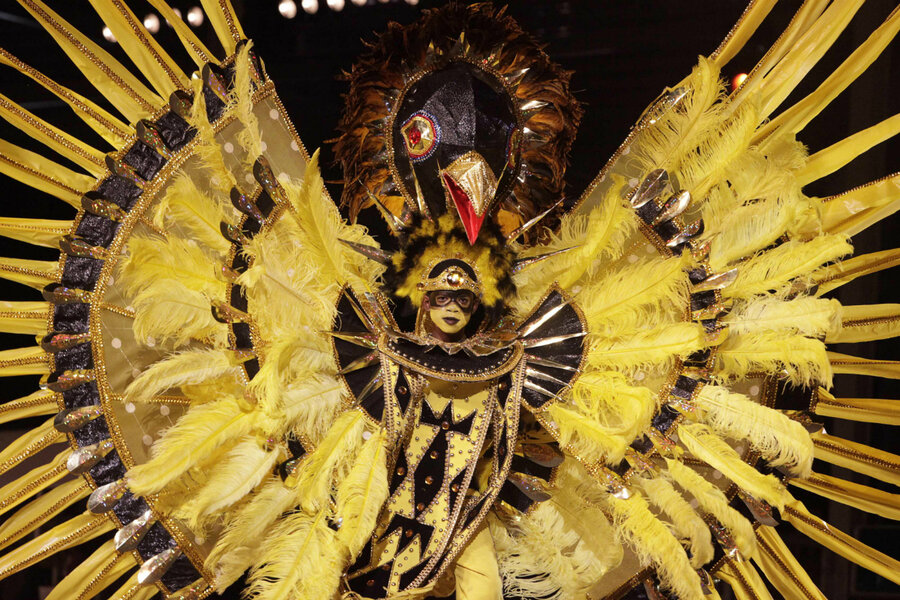Trinidad and Tobago turns to culture to diversify economy
Loading...
| Port of Spain, Trinidad and Tobago
The word for the night was "heat." With that prompt, spoken word artists delivered poems about love, gangs, street food, public transport, and even a trip to the barbershop.
The fashionable 100-strong crowd snapped, clapped, and cheered on the verbal dexterity in this open-air performance space just off Ariapita Avenue in the bustling heart of Trinidad's capital.
The monthly slam poetry event is one of several cultural offerings that have emerged in recent years to liven up the slack period between the annual Carnival celebrations that flood Port of Spain's streets with costumed revelers.
Trinidad and Tobago’s cultural ecosystem still revolves around Carnival, hooked to Ash Wednesday in February or March.
But arts advocates, creative entrepreneurs, and government officials are seeking ways to stimulate a year-round scene that could build an economic alternative for a country otherwise dependent on oil and natural gas.
“I see the creative sector as being key in diversifying our national economy,” said Calvin Bijou, chairman of state-owned cultural promotion enterprise CreativeTT.
Besides rich oil and gas reserves, the twin-island Caribbean country has a wealth of cultural talent.
It is the birthplace of steel pan, widely believed to be the only non-electric, acoustic instrument invented in the 20th century, and the origin of calypso.
Those musical traditions blend with folk crafts like wire-bending and costume design in Trinidad’s world-famous Carnival. Since 2014, it has brought an annual average of 36,000 visitors to the island, who spend some $48 million.
But spreading culturally driven economic activity throughout the year is a tough task, and has sparked debate over whether a small island state should focus on audiences at home or abroad.
Backyard theater
The spoken word event, “True Talk No Lie”, began in 2013 to capitalize on the Carnival off-season.
It runs from March through November, when the cultural calendar heats up again, with parties showcasing the latest soca hits ahead of the next Carnival.
Poets hit the stage at The Big Black Box, a repurposed backyard in the former residence of a respected playwright.
Multimedia production outfit 3canal renovated the space in 2014 as a simple “black box” theater with a mango tree soaring through the roof.
In the off-season, the venue hosts weekly live shows and rehearsals for annual productions.
It has also become an incubator for taking Trinidadian arts abroad. Two of 3canal's rising stars toured Pride and carnival events in Britain and the Netherlands this summer, and ensemble members will perform at the National Theatre of Scotland in November.
In the run-up to Carnival, there are nightly rehearsals for 3canal’s annual show, culminating in Friday night “backyard jams” where spectators can get a taste of the work in progress.
Inside the restored gingerbread house, 3canal maintains a recording studio, office and merchandise store. Having its own infrastructure has allowed the ensemble to escape the constraints of Trinidad’s seasonal cultural scene.
“The convenience of having your own base out of which to explore, express and experiment can’t be beat,” 3canal’s artistic director Wendell Manwarren told the Thomson Reuters Foundation as dancers rehearsed in the courtyard.
“With our new album, we could luxuriate and take our time – as opposed to that Carnival pressure cooker.”
The Big Black Box has joined a cluster of historic residences converted for cultural use within a few blocks of each other in the Woodbrook neighborhood.
A decade ago, a trio of creatives established an artist residency program called Alice Yard. In 2011, Medulla Art Gallery opened to showcase contemporary Caribbean art, while older establishments like the Little Carib Theatre, built in 1947, round out the scene.
Carnival remains the center of gravity for some activities like the #1000mokos project in Alice Yard, which teaches a new generation of stilt walkers – moko jumbies in Carnival parlance.
Visual art is less in thrall to the Carnival rhythm, finding a larger audience through the quiet season. In May, a show opening and talk by an up-and-coming painter packed out the subterranean Medulla gallery.
Global or local?
But as Trinidad's cultural scene grows, it faces a key question: Should it prioritize local audiences or export abroad?
For Rubadiri Victor, president of the Artists' Coalition of Trinidad and Tobago and a former adviser to the arts minister, the answer lies overseas.
When in government from 2013-2014, he fought unsuccessfully to expand the mission of Pan Trinbago, the world body for steel pan set up by Trinidad, to “make pan and rhythm sections the festival music of Planet Earth.”
He wanted the country’s best steel pan bands playing the world’s top festivals, including the dozens of Caribbean-style carnivals in cities globally, which he estimates generate some $2.23 billion in revenues per year.
He pointed to examples of Trinidadian cultural success abroad – from several Olympic opening ceremonies choreographed by Carnival artist Peter Minshall in the 1990s and early 2000s, to the popular steel pan band that accompanied fans to Germany for Trinidad's first-ever World Cup appearance in 2006.
But exporting Trinidadian culture requires public funding and support, Mr. Victor noted. “If you don’t have those enablers, it’s just difficult,” he said.
3canal’s Mr. Manwarren is more interested in local audiences. “We tend to focus too much on outside validation,” he said. “We need to break through to ourselves.”
The government, meanwhile, is trying to straddle both lines.
It runs youth programs to teach steel pan, maintains a national artist registry, and coordinates mentorship by master artists – including Manwarren, who teaches live show production.
It hopes to offer funding for artists to showcase their skills abroad, but lacks a national cultural policy that would streamline such opportunities, though public consultations are underway to develop one.
“The cultural has to be seen as a political tool and priority, alongside energy, trade, and manufacturing,” said Ministry of Arts official Marlon De Bique.
This article was reported by the Thomson Reuters Foundation.







